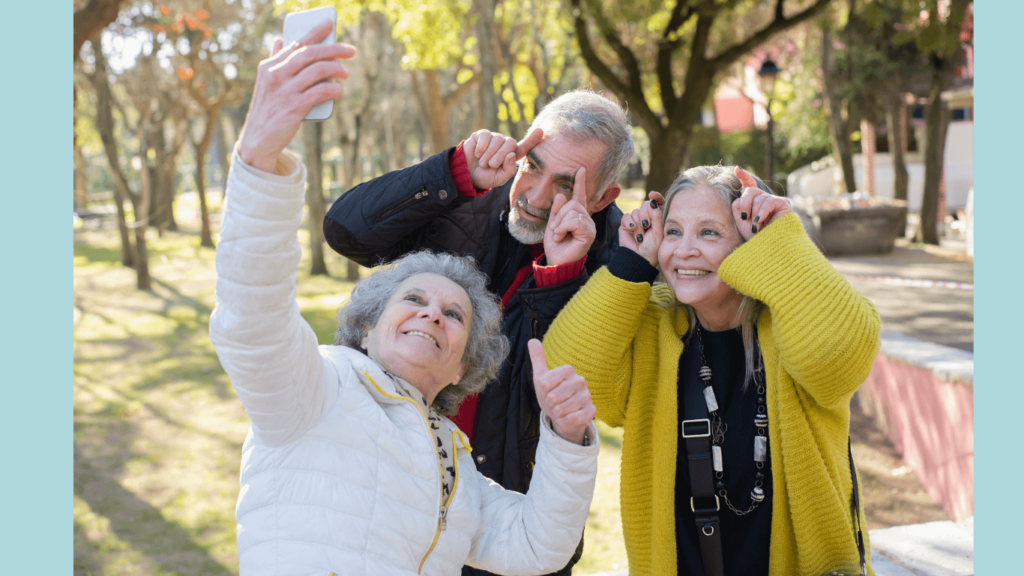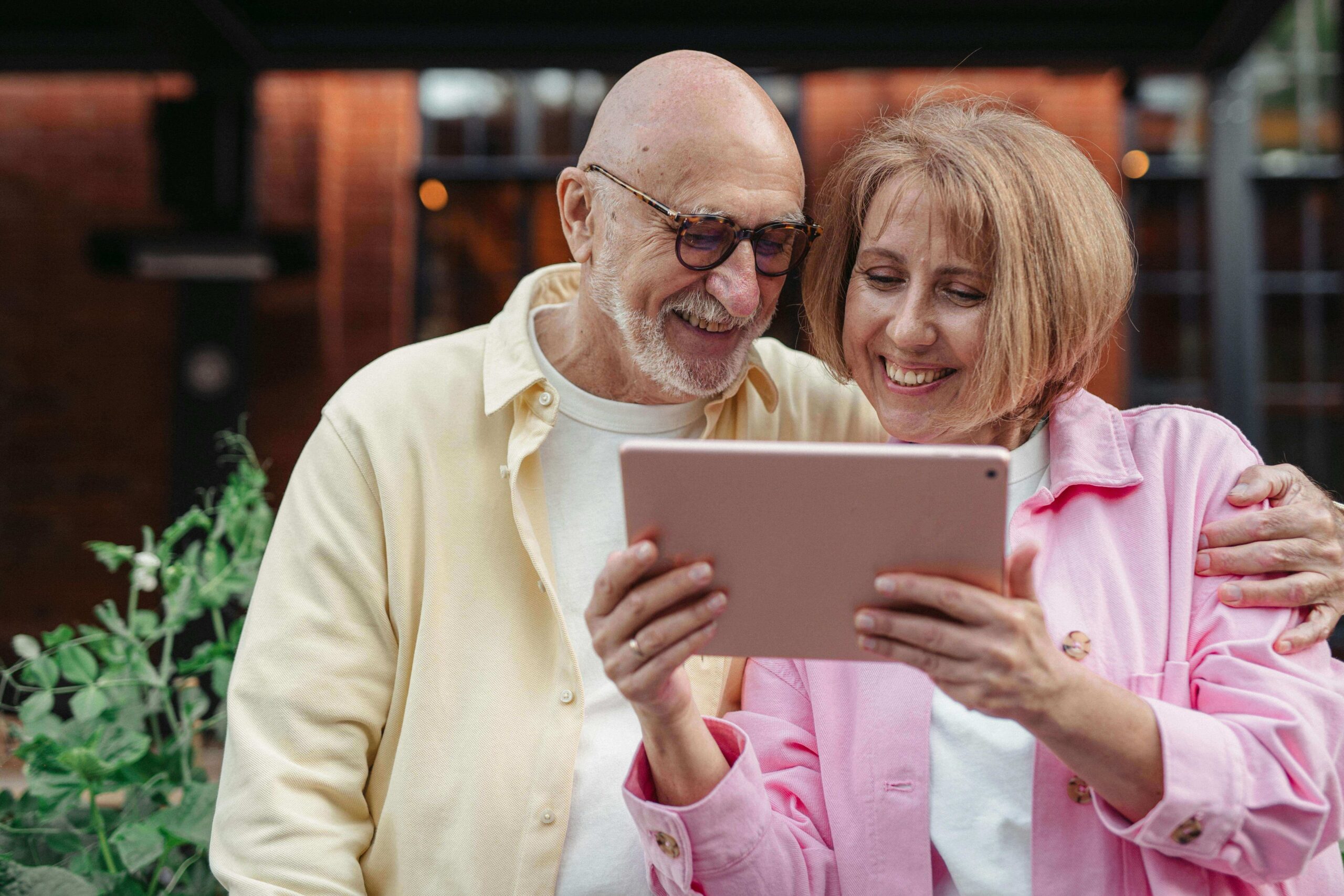07 Jul Seniors and Technology: Embracing the Digital Age
Technology has revolutionized the way seniors communicate, breaking down barriers of distance and isolation. Seniors and technology are a good combination as isolation can be reduced. Video calls, social media platforms, and messaging apps enable them to connect with loved ones effortlessly, regardless of physical distance. These tools foster social engagement, reducing feelings of loneliness and enhancing overall mental well-being.
Seniors can now access a vast array of information, ranging from healthcare advice to hobbies and educational materials. Online platforms also facilitate the delivery of essential services, such as virtual doctor consultations, online shopping, and banking, empowering seniors to maintain their independence.
Technology offers seniors an avenue for staying physically and mentally active. Fitness trackers and health apps encourage regular exercise, monitor vital signs, and promote healthier lifestyles. Smart home technology, wearable devices, and emergency alert systems contribute to senior safety and well-being. These technologies can detect falls, monitor vital signs, and provide immediate assistance in emergencies, granting seniors and their families peace of mind.
Overcoming Challenges for Seniors and Technology.
One of the primary barriers seniors face when it comes to technology is the fear of the unknown.
They might worry about the complexity of devices, the risk of privacy breaches, or even losing touch with traditional ways of communication. To address these fears, patient guidance is crucial. Seniors should be encouraged to start with basic devices and applications, gradually building their confidence. Demonstrating the benefits of technology, such as video calls that bring distant family members closer, can go a long way in dispelling misconceptions.
Digital literacy is the key to unlocking the vast potential of technology. Workshops and training sessions tailored to seniors can help bridge the gap. These sessions should be conducted at a comfortable pace, without overwhelming them with technical jargon. Focusing on practical, everyday applications, such as online shopping, accessing healthcare information, or using social media, can make the learning process more engaging and relevant.
Devices and Applications for Seniors.
Smartphones have revolutionized the way we communicate, access information, and manage daily activities. Seniors can benefit greatly from the convenience and functionality of smartphones.
Mobile apps designed specifically for seniors can assist with tasks such as medication reminders, appointment scheduling, and even tracking vital signs.
Moreover, smartphones enable seniors to easily stay in touch with their loved ones through video calls, messaging apps, and social media platforms.
Tablets and e-readers offer a larger screen size compared to smartphones, making them ideal for entertainment and learning purposes.
Tablets can provide access to online learning platforms and educational apps, enabling seniors to engage in lifelong learning and explore new interests.
For seniors with chronic conditions or specific health concerns, wearable devices (like smartwatches) can play a crucial role in remote health monitoring. These devices can measure heart rate, blood pressure, and sleep patterns, and even detect falls. With the ability to send real-time alerts to caregivers or healthcare providers, wearable technology enhances seniors´ safety and provides peace of mind to both seniors and their loved ones.
Connecting Seniors with the Digital World.

For seniors, engaging in social media platforms can offer a multitude of advantages. Firstly, it fosters social interaction, reducing feelings of loneliness and isolation that some seniors might experience, particularly if they are living alone or far from family and friends.
Social media provides a platform for seniors to become active participants in conversations about current events, cultural trends, and topics they are passionate about. It encourages them to stay informed, share their perspectives, and learn from others.
Video calling has emerged as a powerful tool for bridging geographical distances and staying connected with loved ones.
Moreover, video calls enable face-to-face communication, allowing seniors to see the expressions and emotions of their loved ones. This human touch can be especially meaningful for seniors, assuring them of their importance and reaffirming the bonds of love and affection with their families and friends.
The convenience of online shopping and delivery services has transformed the way people access products and services, and seniors can particularly benefit from this digital revolution. With just a few clicks, seniors can order groceries, medications, clothing, and household items without leaving the comfort of their homes.
Lifelong Learning and Personal Growth.
One of the most significant benefits of the Internet is the wealth of educational platforms and online courses available to learners of all ages. Seniors can now engage in learning from the comfort of their own homes, at their own pace, and explore a wide range of subjects.
Coursera offers a vast selection of online courses from leading universities and institutions worldwide.
Udemy provides an extensive library of courses taught by experts in different fields.
Khan Academy offers free educational content covering subjects like math, science, humanities, and much more.
Visiting museums and experiencing cultural events can be challenging for seniors due to mobility limitations or geographical constraints. However, virtual museums and cultural experiences bring the world to their fingertips. Google Arts & Culture is a platform that collaborates with museums
and cultural institutions worldwide to provide virtual tours and exhibits. The Smithsonian offers virtual tours and exhibits.
Many artists and organizations now offer virtual concerts and performances, which seniors can enjoy from the comfort of their homes. They can indulge in classical music, opera, theater, and other artistic expressions.
Gone are the days when seniors had to rely solely on physical libraries to access books and research material. The internet has opened up a world of information that can be accessed with just a few clicks. Platforms like Amazon Kindle, Audible, and Librivox offer a wide range of e-books
and audiobooks, allowing seniors to indulge in their favorite genres or explore new ones effortlessly.
Safety and Security Measures.

Safeguarding personal information is a fundamental aspect of online safety. Seniors should follow these cybersecurity tips to protect their personal data:
Strong Passwords: Create unique, complex passwords for all online accounts and change them regularly. Avoid using easily guessable information like birthdays or names.
Two-Factor Authentication (2FA): Enable 2FA whenever possible, which adds an extra layer of security by requiring a second form of verification, such as a code sent to your mobile device.
Privacy Settings: Familiarize yourself with privacy settings on social media platforms and other websites. Ensure your personal information is visible only to trusted individuals.
Avoid Oversharing: Be cautious about sharing sensitive information, such as your full name, address, phone number, or financial details, unless necessary.
Online scams pose a significant threat to seniors, who may be more vulnerable to manipulation.
Be wary of unsolicited emails requesting personal information or urging immediate action. Avoid clicking on suspicious links or downloading attachments from unfamiliar sources.
Legitimate tech companies will not proactively contact you for support. Beware of unsolicited calls claiming to offer technical assistance or urgent fixes.
Be skeptical of any offers that sound too good to be true, such as lottery winnings or investment opportunities.
Be cautious of individuals who attempt to manipulate you emotionally or impersonate someone you know. Verify the identity of callers or senders before sharing any personal or financial information.
The Power of Embracing Technology in Later Life.

Through various communication platforms like video calls, emails, and social media, older adults can maintain meaningful relationships, share experiences, and feel less isolated.
Technology bridges the gap between generations, allowing seniors to connect with grandchildren and family members, creating stronger bonds despite physical distances.
The internet provides easy access to a vast array of information, enabling older adults to stay informed, pursue personal interests, and engage in lifelong learning. Online courses, tutorials, and educational platforms offer a chance to explore new subjects, acquire new skills, and expand intellectual horizons, regardless of physical limitations.
Wearable devices, such as fitness trackers or smartwatches, can help monitor physical activity, heart rate, sleep patterns, and overall health. Mobile applications provide access to exercise routines, meditation practices, and healthy living tips, promoting active lifestyles and mental well-being. Additionally, telehealth services enable seniors to consult with healthcare professionals remotely, reducing the need for travel and providing convenient access to medical advice and support.
Technology can greatly simplify everyday tasks for seniors, promoting independence and autonomy. Smart home devices, voice assistants, and home automation systems allow older adults to control lighting, temperature, and other household functions with ease. Online shopping platforms offer convenient access to groceries, medication, and various products.

